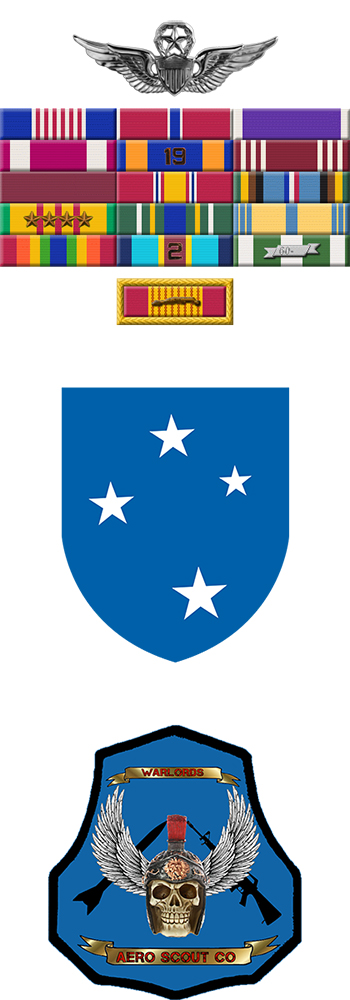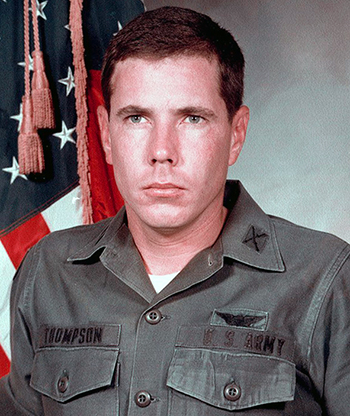
|
Hugh C. Thompson, Jr. |
 |
|||
| Rank, Service | ||||
Major O-4, U.S. Army |
||||
| Veteran of: | ||||
|
||||
| Tribute: | ||||
Hugh Thompson was born on April 15, 1943, in Atlanta, Georgia. He enlisted in the U.S. Navy Reserve on April 15, 1960, serving as a Heavy Equipment Operator with the Naval Reserve Construction Battalion at NAS Atlanta, Georgia, from April to December 1960. He next served with VA-672 at NAS Atlanta in the Naval Reserve from December 1960 to May 1961, and then on active duty with VA-672 at NAS Atlanta from May 25, 1961, until he left active duty on March 26, 1964. Seaman Thompson then served as a Heavy Equipment Operator with the Naval Reserve Construction Battalion at NAS Atlanta from March 27, 1964, to April 14, 1966. Thompson next went on active duty with the U.S. Army on June 30, 1966, and he completed basic training at Fort Polk, Louisiana, in September 1966. He then attended Warrant Officer Candidate School at Fort Wolters, Texas, and then at Fort Rucker, Alabama, from October 1966 until he was designated a rotary-wing Army Aviator and appointed a Warrant Officer in the U.S. Army on August 1, 1967. After additional training he deployed to Southeast Asia in December 1967, and served as an OH-23 Raven helicopter pilot with the 161st Aviation Company (Assault Helicopter) in South Vietnam from December 1967 to January 1968; continuing with the unit after it was reorganized and expanded into the 123rd Aviation Battalion of the 23rd Infantry Division (Americal) in January 1968. WO Thompson served as an OH-23 pilot with Company B of the 123rd Aviation Battalion from January 1968 until he was evacuated to Japan after a helicopter crash later that year. During this time he was one of the three people that attempted to stop the My Lai Massacre on March 16, 1968, for which he would be awarded the Soldier's Medal 30 years later. After recuperating from his injuries, Thompson became a rotary-wing flight instructor at Fort Rucker, Alabama, and he was commissioned a 2d Lieutenant on January 28, 1970. He continued as a flight instructor with the U.S. Army Aviation Regiment and Brigade at Fort Rucker until he attended the Infantry Officer Basic Course at the U.S. Army Infantry School at Fort Benning, Georgia, from March to May 1972. Lt Thompson served as Battalion Instrument Examiner with Company B, 2nd Aviation Battalion of the 2nd Infantry Division in South Korea from July to November 1972, and then as Executive Officer of the unit from November 1972 to May 1973. He next served as Flight Standardization Officer (S-3) with Headquarters Company of the 2nd Aviation Battalion in South Korea from May 1973 until he returned to the United States in July 1973, followed by service with the 3rd Battalion, 1st Basic Combat Training Brigade with the U.S. Army Training Center at Fort Jackson, South Carolina, from August 1973 until he left active duty and joined the U.S. Army Reserve on July 14, 1975. Capt Thompson returned to active duty on September 23, 1975, and then served as a Rotary-Wing Flight Instructor Examiner with the 237th Medical Detachment at Fort Ord, California, from September 1975 to June 1976. His next assignment was as an Instructor Pilot with Headquarters Company, Headquarters Battalion, at Fort Ord from June 1977 to March 1978, and then as a Rotary-Wing Flight Instructor Examiner with Headquarters Company, 14th Engineering Battalion at Fort Ord from March to July 1978. Capt Thompson served as a Rotary-Wing Instructor Flight Examiner with Troop B, 3rd Squadron, 4th Cavalry Regiment of the 25th Infantry Division at Schofield Barracks, Hawaii, from October 1978 to August 1980, and then as an Evacuation Pilot with the 68th Medical Detachment of the 25th Infantry Division at Schofield Barracks from August 1980 to September 1981. Major Thompson's next assigned was as an Instrument Examiner with the 36th Medical Detachment at Fort Polk, Louisiana, from September 1981 to October 1982, followed by service as an Instrument Flight Examiner with the Aviation Company, 5th Combat Aviation Battalion, at Fort Polk from October 1982 until his retirement from the U.S. Army on November 1, 1983. Hugh Thompson died on January 6, 2006, and was buried at Lafayette Memorial Park in Lafayette, Louisiana. |
||||
|
||||

